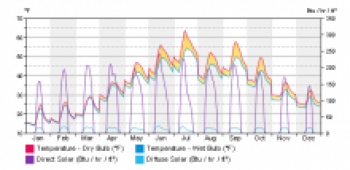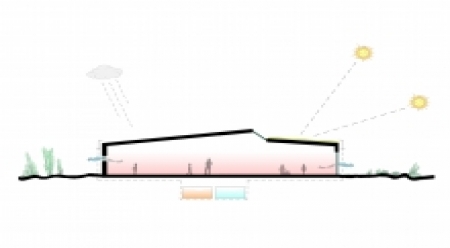As part of a design competition, a team of Italian students designed and analyzed a nursery school for the town of Sluderno, Italy. The team designed the project, conducted conceptual design analyses and documented the process. Based on the analyses, the team was able to determine a site placement and building layout that took advantage solar insolation and protected the site from harsh winter winds. The team also had the challenge of designing to a regional energy code, CasaClima.
Project Requirements
Building Site & Program
The design challenge was to create a nursery school for the city of Sluderno in Northern Italy. The site for the school was set between the Town Hall (to the north-west) and an existing elementary school (to the south-east). The goal was for the nursery school to fit within the layout and aesthetics of the existing context.
 |
| The building site was between the Town Hall to the north, and a 3 story elementary school to the south that shades the site. |
The school needed to accommodate 90 students between the ages of 3 and 5 during the day and promote their mental and physical development. The space also needed to be flexible enough to use for other town activities, including a dedicated practice space for the town’s local band (with typical sound levels between 90 and 100 decibels).
Although the school was to be used year round, because Sluderno is a winter resort town, special attention was given to the performance of the building during the winter season.
Energy Goals: Less than 30 kWh/m2y for heating
The specifications for the project were to achieve "CasaClima A" certification. CasaClima is a regional energy certification that originated near Bolzano and has spread throughout the region. The evaluation tiers are primarily based on the project’s Space Heating Requirements (SHR).
For a project to achieve an A rating (the second highest) it needs to have a space heating requirement of less than 30 kWh/m2y (9.5 kBTU/ft2y). This is less than half of the national legal code of 70 kWh/m2y (22.2 kBTU/ ft2y). [More info on CasaClima in the links below]. Buildings that meet CasaClima A classification are sometimes called “three-liter” buildings because they require the equivalent of 3 liters of diesel fuel per square meter per year to meet thermal comfort requirements.
Design Concept
The team’s concept was a series “little houses” meant to fit in with the town’s aesthetic and make the students feel comfortable in a familiar space. The design has sloped roofs and small windows, and the building materials are primarily local stone and wood. The two story eastern front also provides a view to the urban environment and to the public square.
The rehearsal space and all other rooms for the band do not need to be open to the public, so they are placed in the basement to ensure a total control of sound and heat insulation.
Given this basic concept, conceptual energy analyses were done to refine the building form and orientation.
Design Proces & Tools
Autodesk Revit Architecture was used as the main modeling tool. It facilitated teamwork and enabled precise control of the geometry. This main building information model was then used for energy analysis and technical project drawings.
Autodesk Ecotect Analysis was utilized to do preliminary site analysis and natural lighting analysis.
Autodesk Vasari was used to compare different mass forms based on architectural and energy requirements. The mass model was also used to create a 3D printed model.
Climate Analysis
Because the energy goals and some prescriptive requirements were set by CasaClima, the team did not spend as much time on whole building energy analysis as might be ideal for another project. They did do a series of climate studies to obtain insights and make more informed design decisions.
The city of Sluderno is located at 46°39’ N and 10°35’ E in Italy’s Climate Zone F (ASHRAE/ANSI Climate Zone 7), which is one of the coldest places in Italy (near Bolzano). It is 2,500 feet (760 m) above sea level. It is a heating dominated climate with about 10,000 F (5,500 C) heating degree days.
 |
The graph of the monthly diurnal averages from Vasari shows that the climate is cold (especially between November and April), but that solar radiation is relatively consistent throughout the year. |
Solar Studies and Analyses
Building Orientation
  |
| Summer Solstice (left) Winter Solstice (right) |
  |
| Ecotect Optimum Orientation based on solar radiation values |
Using the Ecotect Optimum Orientation tool and inputting the climatic data of Sluderno, the team found that the best orientation was 160°. Based on this value, a NE-SW orientation was chosen.
The team used Ecotect to study the sun’s path on the site. To understand sun extremes the summer and winter solstices were studied and to understand average conditions, the equinoxes were studied.
From the solar studies, it was found that the building to the southeast shaded the site significantly. To take advantage of the available sunlight the following design decisions were enacted:
• The nursery school was oriented in the available site to minimize overshadowing and maximizing solar exposure for as much of the year as possible. The building was placed in the northern part of the site and a courtyard was created towards the south for the children to play in.
• High windows and skylights were used to take advantage of any available light and energy in the winter.
Solar Insolation Analysis
 |
| From the results, it was verified that the recess of the external walls allowed for the accumulation and redistribution of heat inside the classrooms. |
From Vasari, the cumulative solar radiation during the winter showed available insolation as 120 kWh/m2. From this analysis, it was determined that the solar radiation on the exterior walls could be used to warm the interior spaces.
CasaClima has requirements for horizontal overhangs for south-facing windows. This requirement is intended to reduce overheating in the summer and prevent the need for cooling. While the climate of Sluderno does not have any cooling needs, the overhangs were still implemented to meet CasaClima requirements.
Wind Analysis
The winds in Sluderno can be very strong, especially in the winter. The building and courtyard needed to be protected from these winds.
The frequency diagram below shows that during the winter there are very fast winds coming from the northwest, and slower winds coming from west-southwest. During this very cold period, more than 3% of the time the winds reach speeds as high as 40 m/s (90 mph). In the summer, winds are usually milder (15 m/s, 34 mph) and come from the southeast.
 |
| Because Sluderno is a winter resort, and the school operates during this period of more extreme weather, the team decided to give detailed considerations to the winter months. |
Vasari Wind Tunnel Analysis
Using the wind tunnel tool in Vasari, the team visualized the effect of the surrounding buildings and environment on the winter wind patterns.
Thermal Envelope Performance
The team met and exceeded the prescriptive envelope requirements of CasaClima. The requirements by CasaClima are that wall assemblies have a total thermal transmittance of less than 0.8 W/m2K, with windows required to have a U-value between 1.4 and 2.0 W/m2K.
The wall assemblies exceeded this requirement by specifying 30 cm thick walls composed of brick, insulation, and double-paned low-E glass – with an expected thermal transmittance of 0.3 W/m2K.
Conclusions
Design challenges in this project included a cold and windy climate, a pre-established site, and a regional energy code that dictated some of the design decisions. The team dealt with these challenges by studying the climate data and shadows cast by surrounding buildings to determine how to best place the building on the site. They also studied the sun path and wind analysis results to determine how the configure the building and its multiple programs.
Additional Images
More about the team
amplusBIMstudio's philosophy is to strive for architectural quality by integrating all aspects of design. Our research has developed over the years to focus on technological requirements and architectural quality through the use of BIM through all stages of design. The synthesis of aesthetics, technology, structural, and operational components of buildings has always fascinated us.
For this design, we created workgroups based on collaboration between Professor Angelo Giuseppe Amodeo, three older students and three younger students. The design process was a very important and formative experience, especially for the younger students who dedicated their time outside of class to improve their knowledge and collaborate with the group.











